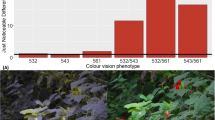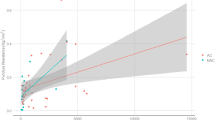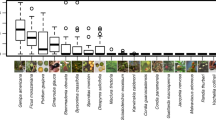Abstract
Figs are important resources for frugivores, and Ficus is an ideal taxon for evaluating patterns of primate foraging related to food color. Ficus spp. can be classified as conspicuous (color change from greenish to reddish during ripening) or cryptic (green throughout ripening). To investigate the effect on foraging of color vision phenotype variation for these 2 types of figs, we conducted a 20-mo study on 4 groups of white-faced capuchins (Cebus capucinus) in the Santa Rosa Sector of the ACG, Costa Rica between May 2004 and September 2008. We genotyped all individuals and collected behavioral data on feeding rates, acceptance indices, and foraging sequences. We found a significant effect of fig type; feeding rates and acceptance indices were higher for conspicuous figs than for cryptic figs, and subjects sniffed cryptic figs more often than conspicuous figs. We also found that dichromats sniffed more figs and had longer foraging sequences than trichromats, especially for cryptic figs. Among 6 subtypes of dichromats and trichromats, monkeys possessing the trichromat phenotype with the most spectrally separated L-M opsin alleles showed the highest acceptance index for conspicuous figs, though there were no differences in feeding rates among phenotypes. We conclude: 1) conspicuous figs are visually salient not only for trichromats but also for dichromats, 2) olfaction is important for evaluating edibility of cryptic figs, and 3) the reliance on olfaction for selecting fruit is greater in dichromats. These results indicate divergent foraging strategies among color vision phenotypes for assessing food items.






Similar content being viewed by others
References
Altmann, J. (1974). Observational study of behaviour: sampling methods. Behaviour, 49, 227–265.
Bergstrom, M. L. (2009). Dominance among female white-faced capuchins at Santa Rosa National Park, Costa Rica. M.A. Thesis, University of Calgary.
Boissinot, S., Tan, Y., Shyue, S.-K., Schneider, H., Sampaio, I., Neiswanger, K., et al. (1998). Origins and antiquity of x-linked triallelic color vision systems in New World monkeys. Proceedings of the National Academy of Sciences, USA, 95, 13749–13754.
Caine, N. G., & Mundy, N. I. (2000). Demonstration of a foraging advantage for trichromatic marmosets (Callithrix geoffroyi) dependant on food colour. Proceedings of the Royal Society of London Series B Biological Sciences, 267, 439–444.
Caine, N. G., Surridge, A. K., & Mundy, N. I. (2003). Dichromatic and trichromatic Geoffrey’s marmosets (Callithrix geoffrey) differ in relative foraging ability for red-green color-camouflaged and non-camouflaged food. International Journal of Primatology, 1163–1175.
Chapman, C., & Fedigan, L. (1990). Dietary differences between neighbouring Cebus capucinus groups: Local traditions, food availability or responses to food profitability? Folia Primatologica, 54, 177–186.
Ciochon, R., & Fleagle, J., (Eds.) (1987). Primate evolution and human origins. Hawthorne, New York: Aldine de Gruyter. 395 p.
Cropp, S., Boinski, S., & Li, W.-H. (2002). Allelic variation in the squirrel monkey x-linked color vision gene: biogeographical and behavioral correlates. Journal of Molecular Evolution, 54, 734–745.
Dominy, N. J. (2004a). Color as an indicator of food quality to anthropoid primates: Ecological evidence and an evolutionary scenario. In C. Ross & R. F. Kay (Eds.), Anthropoid origins: New visions. New York: Kluwer Academic.
Dominy, N. J. (2004b). Fruits, fingers and fermentation: the sensory cues available to foraging primates. Integrative and Comparative Biology, 44, 295–303.
Dominy, N. J., & Lucas, P. W. (2001). Ecological importance of trichromatic vision to primates. Nature, 410(6826), 363–366.
Dominy, N. J., & Lucas, P. W. (2004). Significance of color, calories and climate to the visual ecology of catarrhines. American Journal of Primatology, 62(3), 189–207.
Dominy, N. J., Svenning, J.-C., & Li, W.-H. (2003). Historical contingency in the evolution of primate color vision. Journal of Human Evolution, 44, 25–45.
Dominy, N., Ross, C., & Smith, T. (2004). Evolution of the special senses in primates: past, present and future. Anatomical record, 281A, 1078–1082.
Dominy, N., Lucas, P. W., & Supardi, N. N. (2006). Primate sensory systems and foraging behavior. In G. Hohmann, M. Robbins & C. Boesch (Eds.), Feeding ecology in apes and other primates: Ecological, physiological and behavioural aspects (pp. 489–509). Cambridge: Cambridge University Press.
Dudley, R. (2004). Ethanol, fruit ripening, and the historical origins of human alcoholism in primate frugivory. Integrative and Comparative Biology, 44, 315–323.
Fedigan, L. M., Rose, L. M., & Morera, R. A. (1996). See how they grow. Track capuchin monkey populations in a regenerating Costa Rican dry forest. In M. A. Norconk, A. L. Rosenberger & P. Garber (Eds.), Adaptive radiations of neotropical primates (pp. 289–307). New York: Plenum Press.
Fischer, K. E., & Chapman, C. A. (1993). Frugivores and fruit syndromes: differences in patterns at the genus and species level. Oikos, 66, 472–482.
Fragaszy, D., Visalberghi, E., & Fedigan, L. M. (2004). The complete capuchin monkey. Cambridge, UK: Cambridge University Press.
Gautier-Hion, A., Duplantier, J.-M., Quris, F. F., Sourd, C., Decoux, J.-P., Dubost, G., et al. (1985). Fruit characters as a basis of fruit choice and seed dispersal in a tropical forest vertebrate community. Oecologia, 65, 324–337.
Gilad, Y., Wiebe, V., Przeworski, M., Lancet, D., & Paabo, S. (2007). Correction: loss of olfactory receptor genes coincides with the acquisition of full trichromatic vision in primates. PLoS Biology, 5, e148.
Go, Y., & Niimura, Y. (2008). Similar numbers but different repertoires of olfactory receptor genes in humans and chimpanzees. Molecular Biology and Evolution, 25, 1897–1907.
Hiramatsu, C., Tsutsui, T., Matsumoto, Y., Aureli, F., Fedigan, L. M., & Kawamura, S. (2005). Color vision polymorphism in wild capuchins (Cebus capucinus) and spider monkeys (Ateles geoffroyi) in Costa Rica. American Journal of Primatology, 67(4), 447–461.
Hiramatsu, C., Melin, A. D., Aureli, F., Schaffner, C. M., Vorobyev, M., Matsumoto, Y., et al. (2008). Importance of achromatic contrast in short-range fruit foraging of primates. PLoS One, 3(10), 1–12.
Hiramatsu, C., Melin, A. D., Aureli, F., Schaffner, C. M., Vorobyev, M., & Kawamura, S. (2009). Interplay of olfaction and vision in fruit foraging of spider monkeys. Animal Behaviour, 77, 1421–1426.
Jack, K. M., & Fedigan, L. M. (2006). Why be alpha male? Dominance and reproductive success in wild white-faced capuchins (Cebus capucinus). In A. Estrada, P. A. Garber, M. S. M. Pavelka & L. Luecke (Eds.), New perspectives in the study of mesoamerican primates. Chicago: Springer US.
Jacobs, G. H. (1997). Color vision polymorphisms in New World monkeys: Implications for the evolution of primate trichromacy. In W. G. Kinzey (Ed.), New World primates: Ecology, evolution and behaviour (pp. 45–74). New York: Walter de Gruyter, Inc.
Jacobs, G., & Blakeslee, B. (1984). Individual variation in color vision among squirrel monkeys (Samiri sciureus) of different geographical origins. Journal of Comparative Psychology, 98(4), 347–357.
Jacobs, G. H., & Deegan, I. J. F. (2003). Cone pigment variations in four genera of New World monkeys. Vision Research, 43, 227–236.
Jacobs, G., & Deegan, J. (2005). Polymorphic New World monkeys with more than three M/L cones. Journal of the Optical Society of America A, 22(10), 2072–2079.
Janson, C. (1983). Adaptation of fruit morphology to dispersal agents in a neotropical forest. Science, 219, 187–189.
Janson, C. H. (1990). Ecological consequences of individual spatial choice in foraging groups of brown capuchin monkeys, Cebus apella. Animal Behaviour, 40, 922–934.
Janson, C. H., & Van Schaik, C. P. (1993). Ecological risk aversion in juvenile primates: Slow and steady wins the race. In M. E. Pereira & L. A. Fairbanks (Eds.), Juvenile primates life history, development and behavior (p. 428). New York: Oxford University Press.
Janzen, D. H. (1979). How to be a fig. Annual Review of Ecology Systematics, 10, 13–51.
Kalko, E. K. V., Herre, E. A., & Handley, C. O., Jr. (1996). Relation of fig fruit characteristics to fruit-eating bats in the New and Old World tropics. Journal of Biogeography, 23(4), 565–576.
Knight, R. S., & Siegfried, W. R. (1983). Inter-relationships between type, size and colour of fruits and dispersal in southern African trees. Oecologia, 56, 405–412.
Koenig, A. (2000). Competitive regimes in forest-dwelling Hanuman langur females (Semnopithecus entellus). Behavioral ecology and sociobiology, 48, 93–109.
Laska, M. S., Seibt, A., & Weber, A. (2000). “Microsmatic” primates revisited: olfactory sensitivity in the squirrel monkey. Chemical Senses, 25, 47–53.
Lovell, P. G., Tolhurst, D. J., Parraga, C. A., Baddeley, R., Leonards, U., Troscianko, J., et al. (2005). Stability of the color-opponent signals under changes of illuminant in natural scenes. Journal of the Optical Society of America A, 22(10), 2060–2071.
Lucas, P. W., Darvelle, B. W., Lee, P. K. D., Yuen, T. D. B., & Choong, M. F. (1998). Colour cues for leaf food selection by long-tailed macaques (Macaca fascicularis) with a new suggestion for the evolution of trichromatic colour vision. Folia Primatologica, 69, 139–152.
Lucas, P. W., Dominy, N. J., Riba-Hernandez, P., Stoner, K., Yamashita, N., Loria-Calderon, E., et al. (2003). Evolution and function of routine trichromatic vision in primates. Evolution, 57(11), 2636–2643.
Marshall, A., & Wrangham, R. (2007). Evolutionary consequences of fallback foods. International Journal of Primatology, 28(6), 1219–1235.
Melin, A., Fedigan, L., Hiramatsu, C., Sendall, C., & Kawamura, S. (2007). Effects of colour vision phenotype on insect capture by a free-ranging population of white-faced capuchins (Cebus capucinus). Animal Behaviour, 73(1), 205–214.
Melin, A. D., Fedigan, L. M., Hiramatsu, C., & Kawamura, S. (2008). Polymorphic color vision in white-faced capuchins (Cebus capucinus): is there foraging niche divergence among phenotypes? Behavioral Ecology and Sociobiology, 62, 659–670.
Miller, L. (Ed.) (2002). Eat or be eaten. Cambridge: Cambridge University Press, 297 pp.
Mollon, J. D. (1989). “Tho’ she kneel’d in that place where they grew...” The uses and origins of primate color vision. Journal of Experimental Biology, 146, 21–38.
Mollon, J. D., Bowmaker, J. K., & Jacobs, G. H. (1984). Variations of color vision in a New World primate can be explained by polymorphism of retinal photopigments. Proceedings of the Royal Society of London Series B: Biological Sciences, 222, 373–399.
Morgan, M. J., Adam, A., & Mollon, J. D. (1992). Dichromats detect colour-camouflaged objects that are not detected by trichromats. Proceedings of the Royal Society of London Series B: Biological Sciences, 248, 291–295.
Morin, P. A., Chambers, K. E., Boesch, C., & Vigilant, L. (2001). Quantitative polymerase chain reaction analysis of DNA from noninvasive samples for accurate microsatellite genotyping of wild chimpanzees (Pan troglodytes verus). Molecular Ecology, 10, 1835–1844.
Nei, M., Niimura, Y., & Nozawa, M. (2008). The evolution of animal chemosensory receptor gene repertoires: roles of chance and necessity. Nature Reviews Genetics, 9, 951–963.
Osorio, D., & Vorobyev, M. (1996). Colour vision as an adaptation to frugivory in primates. Proceedings of the Royal Society of London Series B: Biological Sciences, 263, 593–599.
Osorio, D., Smith, A. C., Vorobyev, M., & Buchanan-Smith, H. M. (2004). Detection of fruit and the selection of primate visual pigments for color vision. American Naturalist, 164(6), 696–708.
Parr, N., Melin, A. D., & Fedigan, L. (2009). How fruiting fig trees affect the ranging behavior of wild white-faced capuchins (Cebus capucinus) in Santa Rosa National Park, Costa Rica. 32nd Meeting of the American Society of Primatologists San Diego, California.
Parraga, C. A., Troscianko, T., & Tolhurst, D. J. (2002). Spatiochromatic properties of natural images and human vision. Current Biology, 12, 483–487.
Regan, B. C., Julliot, C., Simmen, B., Vienot, F., Charles-Dominique, P., & Mollon, J. D. (2001). Fruits, foliage and the evolution of primate colour vision. Philosophical Transactions of the Royal Society of London Series B Biological Sciences, 356, 229–283.
Riba-Hernandez, P., Stoner, K. E., & Lucas, P. W. (2005). Sugar concentration of fruits and their detection via color in the Central American spider monkey. American Journal of Primatology, 67(4), 411–423.
Rose, L. M. (1994). Sex differences in diet and foraging behaviour in white-faced capuchins (Cebus capucinus). International Journal of Primatology, 15(1), 95–114.
Rowe, M. P., & Jacobs, G. H. (2004). Cone pigment polymorphism in New World Monkeys: are all pigments created equal? Visual Neuroscience, 21, 217–222.
Saito, A., Kawamura, S., Mikami, A., Ueno, Y., Hiramatsu, C., Koida, K., et al. (2005). Demonstration of genotype-phenotype correlation in polymorphic color vision of a non-callitricine New World monkey, capuchin Cebus apella. American Journal of Primatology, 67(4), 471–485.
Saito, C. (1996). Dominance and feeding success in female Japanese macaques, Macaca fuscata: effects of food patch size and interpatch distance. Animal Behaviour, 51, 967–980.
Smith, A. C., Buchanan-Smith, H. M., Surridge, A. K., Osorio, D., & Mundy, N. I. (2003). The effect of color vision on the detection and selection of fruits by tamarins (Saguinus spp.). Journal of Experimental Biology, 206, 3159–3165.
Sumner, P., & Mollon, J. D. (2000a). Catarrhine photopigments are optimized for detecting targets against a foliage background. Journal of Experimental Biology, 203, 1963–1986.
Sumner, P., & Mollon, J. D. (2000b). Chromacy as a signal of ripeness in fruits taken by primates. Journal of Experimental Biology, 203, 1987–2000.
Surridge, A. K., & Mundy, N. I. (2002). Trans-specific evolution of opsin alleles and the maintenance of trichromatic colour vision in Callitrichine primates. Molecular Ecology, 11, 2157–2169.
Surridge, A. K., Smith, A. C., Buchanan-Smith, H. M., & Mundy, N. I. (2002). Single-copy nuclear DNA sequences obtained from noninvasively collected primate feces. American Journal of Primatology, 56, 185–190.
Surridge, A. K., Osorio, D., & Mundy, N. I. (2003). Evolution and selection of trichromatic vision in primates. Trends in Ecology & Evolution, 51, 198–205.
Tan, Y., & Li, W.-H. (1999). Trichromatic vision in prosimians. Nature, 402, 36.
Terborgh, J. (1983). Five New World primates: A study in comparative ecology. Princeton, NJ: Princeton University Press.
Veilleux, C., & Bolnick, D. (2008). Opsin gene polymorphism predicts trichromacy in a cathemeral lemur. American Journal of Primatology, 70, 1–5.
Vogel, E., Neitz, M., & Dominy, N. (2007). Effect of color vision phenotype in the foraging of white-faced capuchins, Cebus capucinus. Behavioral Ecology, 18, 292–297.
Vogel, E. R. (2005). Rank differences in energy intake rates in white-faced capuchin monkeys, Cebus capucinus: the effects of contest competition. Behavioral ecology and sociobiology, 58, 333–344.
Acknowledgments
We thank James Higham for the invitation to contribute to this issue. We thank R. Blanco Segura, M. M. Chavarria, and other staff of the Area de Conservación Guanacaste for local support and the Ministerio de Ambiente y Energía (MINAE) of Costa Rica for giving us permission to conduct this study in the Santa Rosa Sector of the ACG. We thank Adrian Guadamuz for assistance with tree species identification; Michael Lemmon for data on availability of Ficus; and Adrienne Blauel, Brandon Klug, Courtney Sendall, and Laura Weckman for their assistance in the field. We thank John Addicott and Tak Fung for helpful advice on statistical analyses, and James Higham and 2 anonymous reviewers for helpful suggestions on previous versions of the manuscript. This study was supported by grants from the Leakey Foundation, the Alberta Ingenuity Fund, the Animal Behavior Society, and the National Sciences and Engineering Research Council of Canada (NSERC) to A. D. Melin; NSERC and the Canada Research Chairs Program to L. M. Fedigan; the Grant-in-Aid for the Japan Society for the Promotion of Science (JSPS) Fellows (15-11926) to C. Hiramatsu; and the Grants-in-Aid for Scientific Research (B) (16405015) and (A) (19207018) from JSPS to S. Kawamura. We also thank the British Ecological Society for funding the attendance of AM to present these results at the XXII Congress of the International Primatological Society. All research protocols abide by national law and were approved by the Animal Care Committee (LESARC) of the University of Calgary.
Author information
Authors and Affiliations
Corresponding authors
Rights and permissions
About this article
Cite this article
Melin, A.D., Fedigan, L.M., Hiramatsu, C. et al. Fig Foraging by Dichromatic and Trichromatic Cebus capucinus in a Tropical Dry Forest. Int J Primatol 30, 753–775 (2009). https://doi.org/10.1007/s10764-009-9383-9
Received:
Accepted:
Published:
Issue Date:
DOI: https://doi.org/10.1007/s10764-009-9383-9




